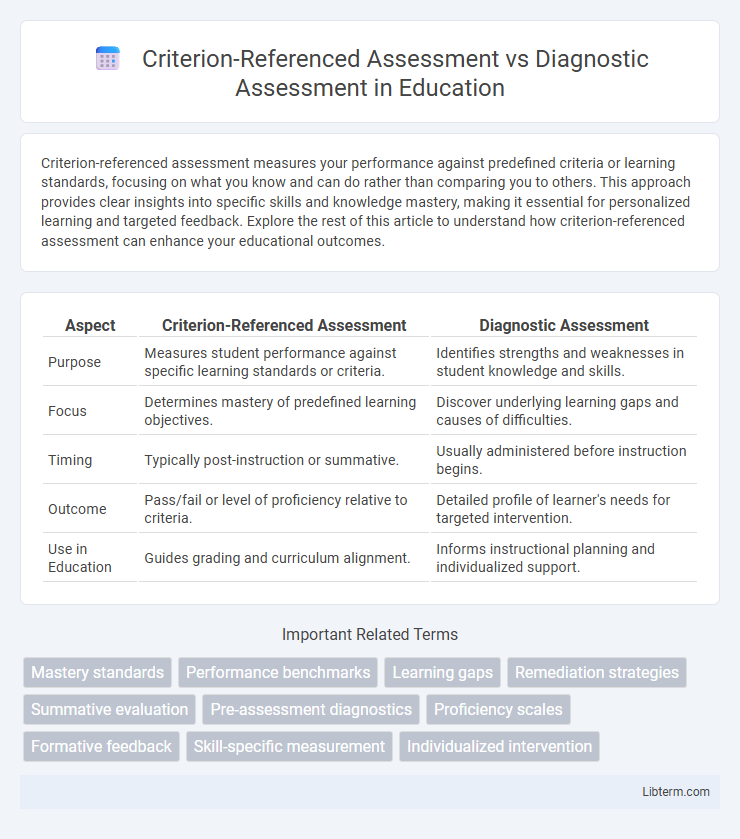Criterion-referenced assessment measures your performance against predefined criteria or learning standards, focusing on what you know and can do rather than comparing you to others. This approach provides clear insights into specific skills and knowledge mastery, making it essential for personalized learning and targeted feedback. Explore the rest of this article to understand how criterion-referenced assessment can enhance your educational outcomes.
Table of Comparison
| Aspect | Criterion-Referenced Assessment | Diagnostic Assessment |
|---|---|---|
| Purpose | Measures student performance against specific learning standards or criteria. | Identifies strengths and weaknesses in student knowledge and skills. |
| Focus | Determines mastery of predefined learning objectives. | Discover underlying learning gaps and causes of difficulties. |
| Timing | Typically post-instruction or summative. | Usually administered before instruction begins. |
| Outcome | Pass/fail or level of proficiency relative to criteria. | Detailed profile of learner's needs for targeted intervention. |
| Use in Education | Guides grading and curriculum alignment. | Informs instructional planning and individualized support. |
Introduction to Assessment Types
Criterion-referenced assessment measures a student's performance against a fixed set of criteria or learning standards, determining whether specific skills or knowledge have been mastered. Diagnostic assessment identifies students' strengths and weaknesses by analyzing detailed learning gaps and misconceptions to guide targeted instruction. Both assessment types play crucial roles in personalized education by providing actionable insights for student progress and instructional planning.
Defining Criterion-Referenced Assessment
Criterion-Referenced Assessment measures a learner's performance against specific learning standards or criteria, indicating whether they have mastered particular skills or knowledge. It focuses on evaluating individual achievement by comparing results to predetermined benchmarks rather than to the performance of other students. This type of assessment provides detailed information about what learners can or cannot do, enabling targeted instruction and skill development.
Understanding Diagnostic Assessment
Diagnostic assessment identifies specific learner strengths and weaknesses by analyzing detailed error patterns and misconceptions. This assessment type targets foundational skills and knowledge gaps to inform personalized instructional strategies and interventions. Unlike criterion-referenced assessment, which measures performance against predefined standards, diagnostic assessment offers granular insights essential for tailored educational support.
Key Differences Between Criterion-Referenced and Diagnostic Assessment
Criterion-referenced assessments measure a learner's performance against predefined standards or learning objectives, providing clear indications of what students know or can do. Diagnostic assessments identify specific strengths and weaknesses in a learner's understanding, guiding targeted instructional interventions. These assessments differ primarily in purpose: criterion-referenced focuses on mastery of content, while diagnostic aims to uncover underlying learning difficulties.
Purposes and Goals of Each Assessment
Criterion-referenced assessment aims to measure a learner's performance against predefined learning standards or specific objectives, ensuring mastery of particular skills or knowledge. Diagnostic assessment identifies individual learner strengths and weaknesses to inform targeted instructional interventions and support personalized learning plans. Both assessments serve distinct educational purposes: criterion-referenced assessment evaluates achievement relative to criteria, while diagnostic assessment guides instructional decisions based on detailed learner analysis.
Methods and Tools Used
Criterion-referenced assessments utilize predefined benchmarks and focused rubrics to evaluate student performance against specific learning objectives, often employing tests, performance tasks, and checklists as primary tools. Diagnostic assessments employ detailed error analysis, formative quizzes, and adaptive testing methods to identify students' strengths and weaknesses, providing targeted insights for personalized instruction. Both methods rely on data-driven instruments, but criterion-referenced assessments emphasize mastery of content standards while diagnostic assessments focus on uncovering learning gaps.
Benefits of Criterion-Referenced Assessment
Criterion-referenced assessment offers clear benefits by measuring student performance against predefined learning objectives, which facilitates targeted instruction and individualized feedback. This type of assessment ensures that educators can identify specific skills mastered or needing improvement, enhancing curriculum alignment and promoting mastery learning. It also supports consistent evaluation standards, making it easier to track progress over time and improve educational outcomes.
Advantages of Diagnostic Assessment
Diagnostic assessment provides detailed insights into learners' specific strengths and weaknesses, enabling tailored instruction and targeted interventions. It enhances early identification of learning gaps and misconceptions, which supports personalized learning plans and improves overall academic outcomes. This form of assessment promotes efficient resource allocation by focusing teaching efforts exactly where they are needed most.
Practical Examples in Educational Settings
Criterion-referenced assessments measure students' mastery of specific skills or knowledge based on predefined criteria, such as a math test aligned with grade-level standards that determines whether a student can solve quadratic equations. Diagnostic assessments identify learning gaps and misconceptions through tools like reading fluency drills or spelling inventories, helping educators tailor interventions for individual student needs. For example, a teacher may use a criterion-referenced science quiz to evaluate understanding of photosynthesis, then follow up with a diagnostic assessment if errors suggest foundational gaps in biology concepts.
Choosing the Right Assessment for Your Needs
Criterion-referenced assessments measure student performance against predefined learning objectives, ideal for determining mastery of specific skills or content standards. Diagnostic assessments identify individual strengths and weaknesses to inform targeted instruction and intervention strategies. Selecting the appropriate assessment depends on whether the goal is to evaluate achievement of criteria or to diagnose learning gaps for personalized support.
Criterion-Referenced Assessment Infographic

 libterm.com
libterm.com